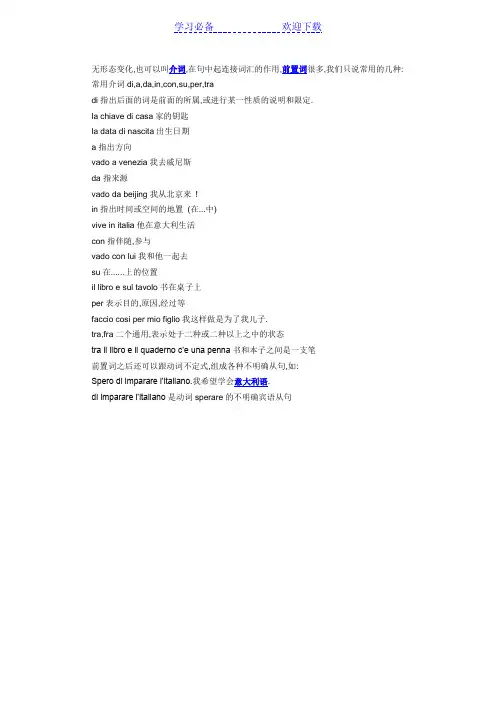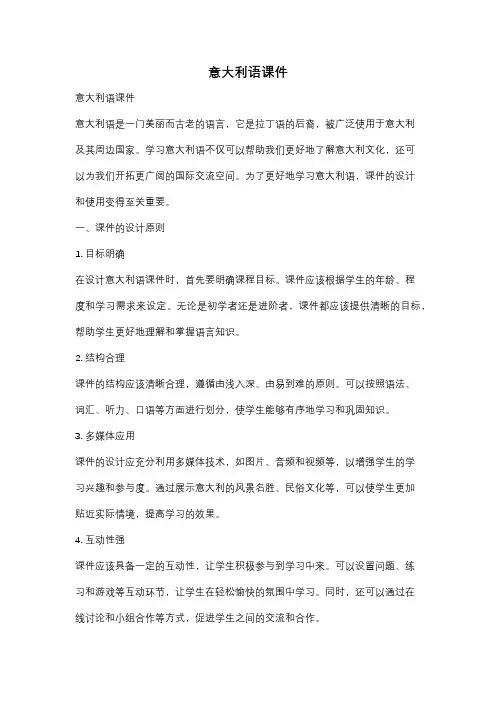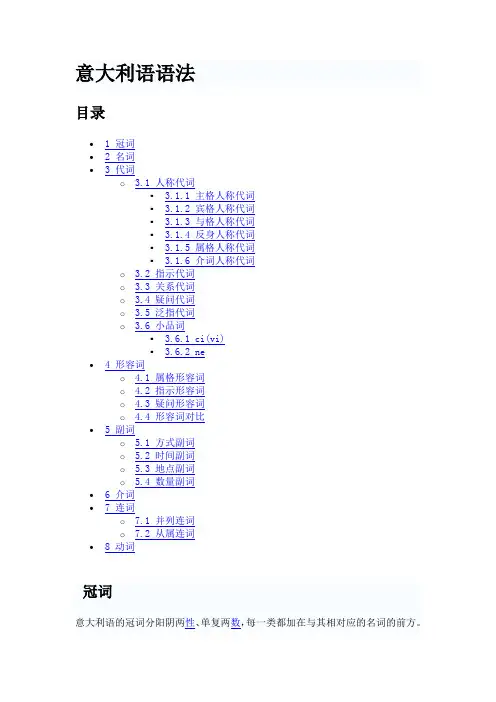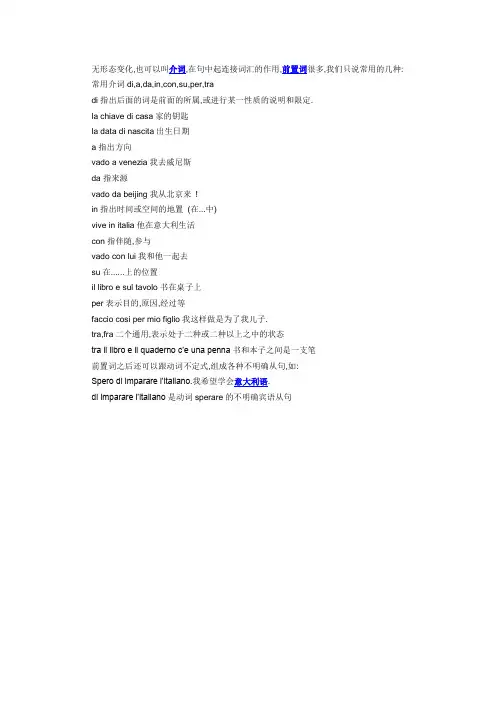初级意语11介词中级用法 意大利语教学课件
- 格式:ppt
- 大小:305.50 KB
- 文档页数:3

无形态变化,也可以叫介词,在句中起连接词汇的作用,前置词很多,我们只说常用的几种: 常用介词di,a,da,in,con,su,per,tradi指出后面的词是前面的所属,或进行某一性质的说明和限定.la chiave di casa家的钥匙la data di nascita出生日期a指出方向vado a venezia我去威尼斯da指来源vado da beijing我从北京来!in指出时间或空间的地置(在...中)vive in italia他在意大利生活con指伴随,参与vado con lui我和他一起去su在......上的位置il libro e sul tavolo书在桌子上per表示目的,原因,经过等faccio cosi per mio figlio我这样做是为了我儿子.tra,fra二个通用,表示处于二种或二种以上之中的状态tra il libro e il quaderno c’e una penna书和本子之间是一支笔前置词之后还可以跟动词不定式,组成各种不明确从句,如:Spero di imparare l’italiano.我希望学会意大利语.di imparare l’italiano是动词sperare的不明确宾语从句AThe Italian preposition a can mean "to," "at," or "in," depending on how you use it in context. You will need preposition a in the following cases:1. To express the idea of going somewhere or staying somewhere (with names of cities):Vado a Milano. (I go to Milan.)Vado al mercato ogni lunedì. (I go to the market every Monday.)Si trova a Venezia. (It can be found in Venice.)Si trova alla piazza. (It can be found in the plaza.)2. Before direct objects:Scriva a Rita. (He/she writes to Rita.)Scriviamo alla zia. (We write to our aunt.)Telefono agli amici. (They call their friends.)3. The preposition a is also used with several verbs. Often those are verbs of motion, but in other instances it's a case of usage. That means either you'll have to commit them to memory, or, more likely, you'll grow accustomed to the usage over time as you listen and read Italian: andare a... (to go to)fermarsi a... (to stop)incoraggiare a... (to encourage)invitare a... (to invite to)insegnare a... (to teach)riuscire a... (to be careful)venire a... (to come to)4. To form several grammatical constructions with particular significance:a mezzogiorno (at noontime)alle tre (at three)barca a vela (sailboat)sedia a rotelle (wheelchair)Usually the Italian preposition in means "in" in English, but it can also mean "to" or "by"! The preposition in is used in the following cases.1. To express the idea of going somewhere or staying somewhere (with countries, continents, regions, large islands, and addresses): Vado in Italia. (I am going to Italy.)Vado nella Sicilia. (I am going to Sicily.)Abita in Germania. (He/she lives in Germany.)Roma è in Italia. (Rome is in Italy.)2. In describing a method of transportation:Andiamo in macchina. (We are going by car.)Andiamo in autobus. (We are going by bus.)Viaggiamo in aereo. (We are traveling by plane.)Viaggiamo in barca. (We are traveling by boat.)3. In dates—note that nel is the contraction for the prepositional article in + il:Cristoforo Colombo è nato nel 1451. (Christopher Columbus was born in 1451.)Caravaggio è morto nel 1570. (Caravaggio died in 1570.)The Italian preposition da means "from" in English. This preposition is used in time expressions, in which case you may translate it as "since" or "for." Italian uses the construction of present tense + da + time expressions to indicate an action that began in the past and is still going on in the present. For example:Da quanto tempo leggi questa rivista? (How long have you been reading this magazine?)Leggo questa rivista da molto tempo. (I've been reading this magazine for a long time.)Da is also used in the following instances:1. To express the equivalent of the English phrase "at the house of":Vado dal fratello. (I'm going to my brother's house.)Vado da Filippo. (I'm going to Filippo's house.)Andiamo dai signori Rossi. (We're going to the Rossi's house.)Andiamo da Gino. (We're going to Gino's house.)2. To indicate origin or source:Vengo da Torino. (I come from Torino.)Vengo dalla Francia. (I come from France.)è tornato dalle vacanze. (He is back from vacation.)è tornato dagli zii. (He is back from his aunt an d uncle's house.)3. To indicate the worth or price of something:Voglio un francobollo da cento lire. (I want a 100 lire stamp.) è una casa da poco prezzo. (It's a house of little worth.)The Italian preposition di means "of" in English. It is used in the following cases:1. To indicate possession:il libro di Maria (Maria's book)la padella del cuoco (the cook's pan)la casa dello zio (the uncle's house)2. To indicate what an object is made of:il tavolo di legno (wooden table)la spada di metallo (metal knife)la medaglia di bronzo (bronze medal)3. To indicate origin using the verb essere + di + nome di città (name of the city):Elisa è di Napoli. (Elisa is from Napoli.)Maurizio è di Prato. (Maurizio is from Prato.)I Rossi sono di Catania. (The Rossis are from Catania.)4. The preposition di is used with certain verbs and adjectives:Accorgersi di qualcosa (to notice something)Innamorarsi di qualcuno (to be in love with someone)Malato di una malattia (ill with a sickness)Vergognarsi di qualcosa (to be ashamed by something)5. The preposition di is found in many particular grammatical constructions:di sera (during the evening)di notte (at night)d'estate (during the summer) un uomo di mezza età (a man of middle age。


意大利语课件意大利语课件意大利语是一门美丽而古老的语言,它是拉丁语的后裔,被广泛使用于意大利及其周边国家。
学习意大利语不仅可以帮助我们更好地了解意大利文化,还可以为我们开拓更广阔的国际交流空间。
为了更好地学习意大利语,课件的设计和使用变得至关重要。
一、课件的设计原则1. 目标明确在设计意大利语课件时,首先要明确课程目标。
课件应该根据学生的年龄、程度和学习需求来设定。
无论是初学者还是进阶者,课件都应该提供清晰的目标,帮助学生更好地理解和掌握语言知识。
2. 结构合理课件的结构应该清晰合理,遵循由浅入深、由易到难的原则。
可以按照语法、词汇、听力、口语等方面进行划分,使学生能够有序地学习和巩固知识。
3. 多媒体应用课件的设计应充分利用多媒体技术,如图片、音频和视频等,以增强学生的学习兴趣和参与度。
通过展示意大利的风景名胜、民俗文化等,可以使学生更加贴近实际情境,提高学习的效果。
4. 互动性强课件应该具备一定的互动性,让学生积极参与到学习中来。
可以设置问题、练习和游戏等互动环节,让学生在轻松愉快的氛围中学习。
同时,还可以通过在线讨论和小组合作等方式,促进学生之间的交流和合作。
二、课件内容的安排1. 基础知识意大利语的基础知识包括字母、发音、基本词汇和常用短语等。
课件可以通过图文并茂的方式,向学生介绍意大利语的基本知识,并提供相关的练习和听力材料,帮助学生掌握基本的语音和词汇。
2. 语法和句型意大利语的语法和句型是学习的重点和难点。
课件可以通过简洁明了的解释和例句,帮助学生理解和掌握各种语法规则和句型结构。
同时,可以提供一些实用的句子模板,让学生在实际应用中灵活运用。
3. 语言技能意大利语的学习不仅仅是掌握语法和词汇,还需要培养听、说、读、写等语言技能。
课件可以通过录音和视频等方式,提供丰富的听力材料,让学生在模仿和理解中提高听力水平。
同时,还可以设置口语练习和写作任务,让学生在实践中提升口头和书面表达能力。

意大利语语法目录• 1 冠词• 2 名词• 3 代词o 3.1 人称代词▪ 3.1.1 主格人称代词▪ 3.1.2 宾格人称代词▪ 3.1.3 与格人称代词▪ 3.1.4 反身人称代词▪ 3.1.5 属格人称代词▪ 3.1.6 介词人称代词o 3.2 指示代词o 3.3 关系代词o 3.4 疑问代词o 3.5 泛指代词o 3.6 小品词▪ 3.6.1 ci(vi)▪ 3.6.2 ne• 4 形容词o 4.1 属格形容词o 4.2 指示形容词o 4.3 疑问形容词o 4.4 形容词对比• 5 副词o 5.1 方式副词o 5.2 时间副词o 5.3 地点副词o 5.4 数量副词• 6 介词•7 连词o7.1 并列连词o7.2 从属连词•8 动词名词意大利语的名词分阳性和阴性两大类,并有单复数的变化。
不过一般而言,意大利语对格的变化已经退化了,故大多数的词仅会对该词所属的性别与指称的数量做相对应的变化。
请协助扩充此章节。
更进一步的讯息可能会在或讨论页或扩充请求中找到。
请在扩充章节后将此模板移除。
代词人称代词主格人称代词宾格人称代词与格人称代词反身人称代词属格人称代词介词人称代词在某些介词后要应用这些特殊的人称代词:指示代词指示代词包括两个,即questo和quello。
questo 这个 quello 那个形容词属格形容词指示形容词•Questo•Quello疑问形容词形容词对比副词方式副词•主要表示状态和方式•回答Come?或In che modo?等问题时间副词•例如:oggi今天,ierie昨天,domani明天,adesso现在,prima以前,dopo 以后,anche还•表示时间,回答Quando?等问题地点副词•例如:qui这里,qua那里,sotto下面,su上面,vicino/pressso附近,dopo 哪里,altrove其他地方,dappertutto到处•可表示地点,回答dove?等问题数量副词•例如:molto很.非常,troppo太,pocO少,almeno至少,solo/soltanto仅仅•表示一定的数量和程度,回答Quanto?等问题介词•缩合前置词介词与个别定冠词组合时会有以下特殊的变体:di del dello della dei degli delleda dal dallo dalla dai dagli dallecon col collo colla coi cogli colleper pel pei•o PS:现在意大利语中一般不合并con,per.连词并列连词连接词汇或并列句例:• e (ed) 和、与•o 或•ma 但、不过•però可是,但是从属连词连接从句例:•se 假如、如果•perché因为•che(引导从句,相当于英语中的that)动词意大利语动词变位(意大利语:la coniugazione),是指意大利语动词为了表达不同的语式、时态、体、人称或数而改变动词词尾的后缀与辅助动词的形式。



无形态变化,也可以叫介词,在句中起连接词汇的作用,前置词很多,我们只说常用的几种: 常用介词di,a,da,in,con,su,per,tradi指出后面的词是前面的所属,或进行某一性质的说明和限定.la chiave di casa家的钥匙la data di nascita出生日期a指出方向vado a venezia我去威尼斯da指来源vado da beijing我从北京来!in指出时间或空间的地置(在...中)vive in italia他在意大利生活con指伴随,参与vado con lui我和他一起去su在......上的位置il libro e sul tavolo书在桌子上per表示目的,原因,经过等faccio cosi per mio figlio我这样做是为了我儿子.tra,fra二个通用,表示处于二种或二种以上之中的状态tra il libro e il quaderno c’e una penna书和本子之间是一支笔前置词之后还可以跟动词不定式,组成各种不明确从句,如:Spero di imparare l’italiano.我希望学会意大利语.di imparare l’italiano是动词sperare的不明确宾语从句AThe Italian preposition a can mean "to," "at," or "in," depending on how you use it in context. You will need preposition a in the following cases:1. To express the idea of going somewhere or staying somewhere (with names of cities):Vado a Milano. (I go to Milan.)Vado al mercato ogni lunedì. (I go to the market every Monday.)Si trova a Venezia. (It can be found in Venice.)Si trova alla piazza. (It can be found in the plaza.)2. Before direct objects:Scriva a Rita. (He/she writes to Rita.)Scriviamo alla zia. (We write to our aunt.)Telefono agli amici. (They call their friends.)3. The preposition a is also used with several verbs. Often those are verbs of motion, but in other instances it's a case of usage. That means either you'll have to commit them to memory, or, more likely, you'll grow accustomed to the usage over time as you listen and read Italian: andare a... (to go to)fermarsi a... (to stop)incoraggiare a... (to encourage)invitare a... (to invite to)insegnare a... (to teach)riuscire a... (to be careful)venire a... (to come to)4. To form several grammatical constructions with particular significance:a mezzogiorno (at noontime)alle tre (at three)barca a vela (sailboat)sedia a rotelle (wheelchair)Usually the Italian preposition in means "in" in English, but it can also mean "to" or "by"! The preposition in is used in the following cases.1. To express the idea of going somewhere or staying somewhere (with countries, continents, regions, large islands, and addresses): Vado in Italia. (I am going to Italy.)Vado nella Sicilia. (I am going to Sicily.)Abita in Germania. (He/she lives in Germany.)Roma è in Italia. (Rome is in Italy.)2. In describing a method of transportation:Andiamo in macchina. (We are going by car.)Andiamo in autobus. (We are going by bus.)Viaggiamo in aereo. (We are traveling by plane.)Viaggiamo in barca. (We are traveling by boat.)3. In dates—note that nel is the contraction for the prepositional article in + il:Cristoforo Colombo è nato nel 1451. (Christopher Columbus was born in 1451.)Caravaggio è morto nel 1570. (Caravaggio died in 1570.)The Italian preposition da means "from" in English. This preposition is used in time expressions, in which case you may translate it as "since" or "for." Italian uses the construction of present tense + da + time expressions to indicate an action that began in the past and is still going on in the present. For example:Da quanto tempo leggi questa rivista? (How long have you been reading this magazine?)Leggo questa rivista da molto tempo. (I've been reading this magazine for a long time.)Da is also used in the following instances:1. To express the equivalent of the English phrase "at the house of":Vado dal fratello. (I'm going to my brother's house.)Vado da Filippo. (I'm going to Filippo's house.)Andiamo dai signori Rossi. (We're going to the Rossi's house.)Andiamo da Gino. (We're going to Gino's house.)2. To indicate origin or source:Vengo da Torino. (I come from Torino.)Vengo dalla Francia. (I come from France.)è tornato dalle vacanze. (He is back from vacation.)è tornato dagli zii. (He is back from his aunt and u ncle's house.)3. To indicate the worth or price of something:Voglio un francobollo da cento lire. (I want a 100 lire stamp.) è una casa da poco prezzo. (It's a house of little worth.)The Italian preposition di means "of" in English. It is used in the following cases:1. To indicate possession:il libro di Maria (Maria's book)la padella del cuoco (the cook's pan)la casa dello zio (the uncle's house)2. To indicate what an object is made of:il tavolo di legno (wooden table)la spada di metallo (metal knife)la medaglia di bronzo (bronze medal)3. To indicate origin using the verb essere + di + nome di città (name of the city):Elisa è di Napoli. (Elisa is from Napoli.)Maurizio è di Prato. (Maurizio is fro m Prato.)I Rossi sono di Catania. (The Rossis are from Catania.)4. The preposition di is used with certain verbs and adjectives:Accorgersi di qualcosa (to notice something)Innamorarsi di qualcuno (to be in love with someone)Malato di una malattia (ill with a sickness)Vergognarsi di qualcosa (to be ashamed by something)5. The preposition di is found in many particular grammatical constructions:di sera (during the evening)di notte (at night)d'estate (during the summer) un uomo di mezza età (a man of middle age。